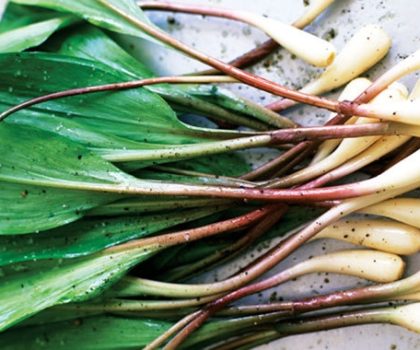Ramping up

By Olivia Bloom
When the forest floor is warmed by the sun, before the trees leaf out, ramps make their way into the light. And folks in the know are ready to harvest this harbinger of the new foraging season. As long as I can remember my dad was one of those folks.
Ramps (allium tricoccum), for those who haven’t caught the fever, are wild onions that grow in the Eastern United States. In the raw, they taste like a strong onion with finishes of garlic. Cooked for short periods of time, they mellow. No matter, they’re easily addictive to the alliumphile.
At times, my dad ate so many of the bulbs that he’d sweat the aroma and mom would make him sleep on the couch. This isn’t unusual. The same thing will happen if you eat a lot of garlic. Dad found them in fields near his work and took advantage of their abundance. He had to move fast because that abundance is short lived.
In Northeast Ohio it starts around late March, early April and continues until nature says stop. That’s usually when the new leaves of forest trees shade the ground. Brian Doyle, chef/owner of Café Avalaun in Warrensville Heights, discovered this Appalachian onion as a child when his dad took him foraging in West Virginia. He’s part of the cadre of chefs who have elevated it to gourmet during the last 25 years.
“I use them in chimichurri, pesto. I like grilling them over a wood flame,” he said.
As for me, I found my first patch on my own in the mid-2000s during an Easter egg hunt in Chardon. While my sons gathered pastel eggs filled with candy and cash, I gingerly pulled bulbs from the earth. Harvested correctly, the plant population proliferates. Harvested harshly, they won’t return.
Proud of my haul, I fried thin slices with diced potatoes. Disappointed, I got nothing. Thus, I learned that ramps become bland when exposed to heat for too long.
Doug Katz, chef/owner of Fire in Shaker Square, explained the delicacy of these wild things.
“I wouldn’t eat them raw. When raw they’re just so pungent. It’s nice to take the pungency off of them. I wash them, cut the bottom stem off and flash grill them for less than 25 seconds,” he says. “No oil or anything. Or I roast them at 400 degrees Fahrenheit for 3-5 minutes. You really just want to soften them. They’re great finishing a pasta or in a compound butter. They add such a great aromatic flavor to an omelet, aioli, pesto. Their flavor is so intense you don’t need a lot of them.”
Doug discovered them at a farmers market. Today, his staff picks their own at a private source. Harvesting on public lands is forbidden.
Ben Bebenroth, chef/owner of Spice Kitchen + Bar in Cleveland, uses an awe-inspiring 400 to 1,000 pounds in a single season. He harvests on private land and buys from foragers.
“We do everything with them. We do an amazing pickled ramp bulb. We take the greens and chop them up really fine and make pesto. You have to cut across the greens to prevent the long fibers from wrapping around your food processor blade.”
Among his most enticing dishes are goat-cheese-and-ramp-filled ravioli and steak with grilled ramps and blue cheese.
Just don’t eat too many.
